The General and the Jaguar (63 page)
Read The General and the Jaguar Online
Authors: Eileen Welsome

Mexicans flocked to the army camps to sell the soldiers foodstuffs and other items.
(Deming Luna Mimbres Museum)
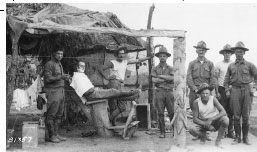
A barbershop, Troop C, Eleventh Cavalry, Dublán, Mexico.
(National Archives)

Colonel Herbert Slocum, shown holding a cigar, lost thirty pounds during the Punitive Expedition and eventually left Mexico
for health reasons.
(Courtesy of Eileen Slocum)
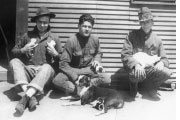
U.S. soldiers assigned to border duty adopted cats and dogs and often kept them in their tents. Note the sand goggles perched
on the hat of the young man on the right.
(Columbus Historical Society Museum)

Workmen put the finishing touches on the gallows from which six Villistas were hung in Deming, New Mexico, in June 1916.
(Deming Headlight)

Jesús Paez, age twelve, was shot during the raid and later was forced to undergo an amputation. He claimed his father was
a member of Villa’s vaunted Dorados, but his story was full of contradictions, and many years later one of the raiders said
Paez was actually a resident of Columbus who had been accidentally shot by the U.S. troops.
(Deming Luna Mimbres Museum)

José Rodriguez was one of the seven Villistas convicted of murder in the Columbus raid but escaped the hangman’s noose when
the governor commuted his death sentence.
(New Mexico State Records Center and Archives)
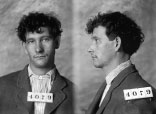
Juan Muñoz, one of the nearly two dozen Villistas captured in Mexico by General Pershing’s troops, had attended college and
was the son of one of the leading citizens of Namiquipa. Documents show that he later served as an informant for the U.S.
Army.
(New Mexico State Records Center and Archives)

Sergeant Benjamin McGhee was fatally wounded during the Parral fight when a bullet entered his mouth and lodged in his throat.
Shown here are members of the Hospital Corps carrying him toward a waiting ambulance.
(Gallery of the Open Frontier)
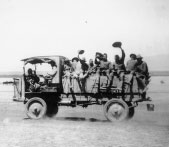
A truck filled with high-spirited U.S. soldiers near the town of Namiquipa, Mexico.
(Gallery of the Open Frontier)
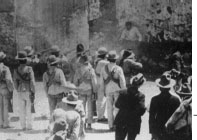
Pablo López, shot through both legs during the Columbus raid, returned to Mexico with the fleeing Villistas, but eventually
he was forced to hide in a cave. Exhausted and malnourished, he finally gave himself up to the Carrancistas and was executed
by a firing squad in Chihuahua City.
(Courtesy of Robert Bouilly)

Candelario Cervantes, seated in the front row and holding a sword, was one of Villa’s most loyal officers and got many of
the men from his hometown of Namiquipa to reenlist by threatening to kill their families. To his right is José Bencomo, who
was killed along with Cervantes byU.S. troops in May 1916.
(Columbus Historical Society Museum)
